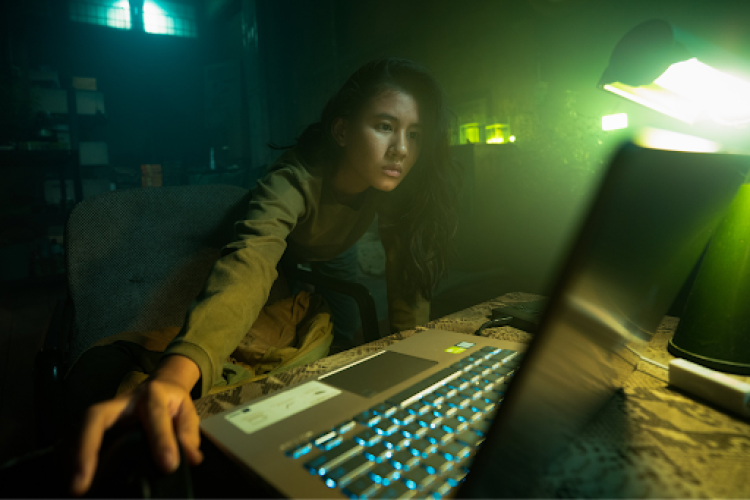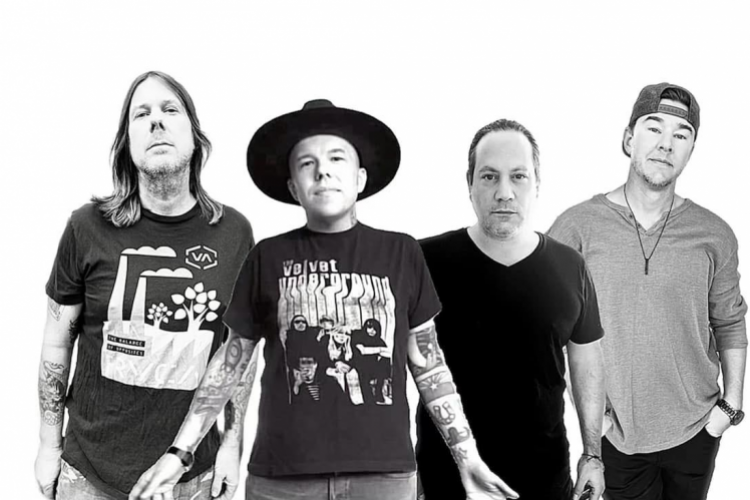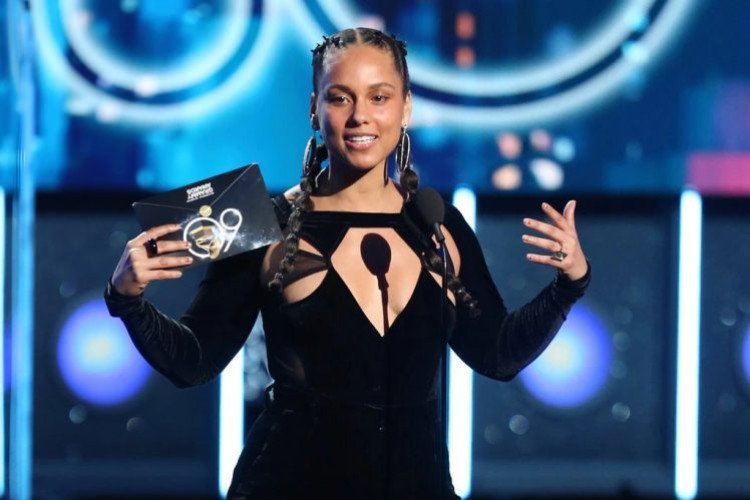Visualizing the Personal with Erik Pauhrizi
Ken Jenie (K) visits Erik Pauhrizi (E) in his Bandung Studio
by Ken Jenie
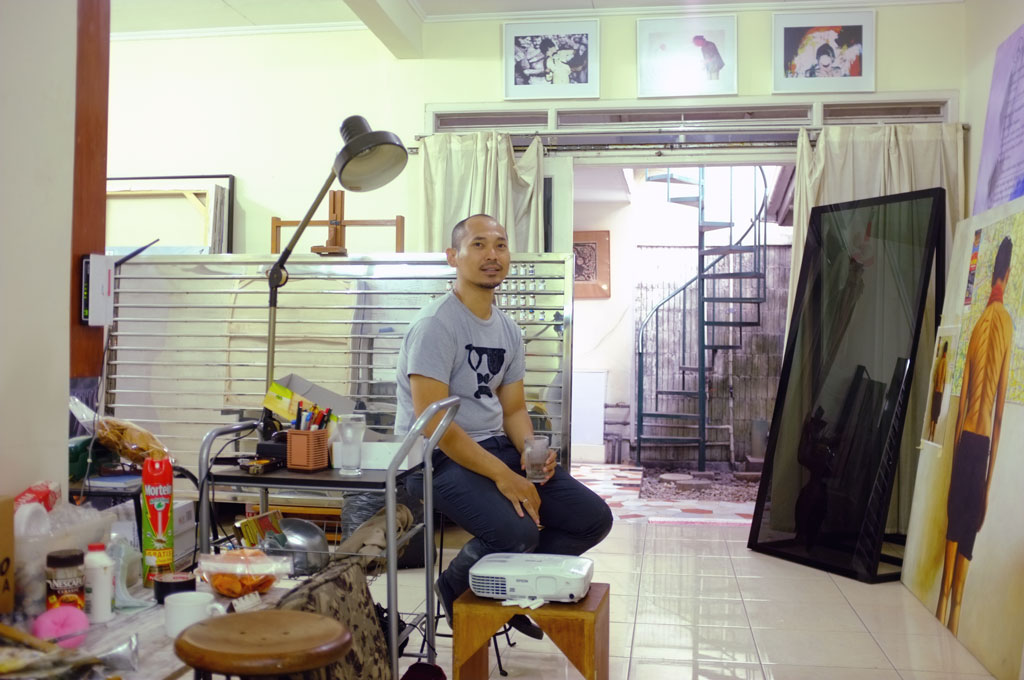
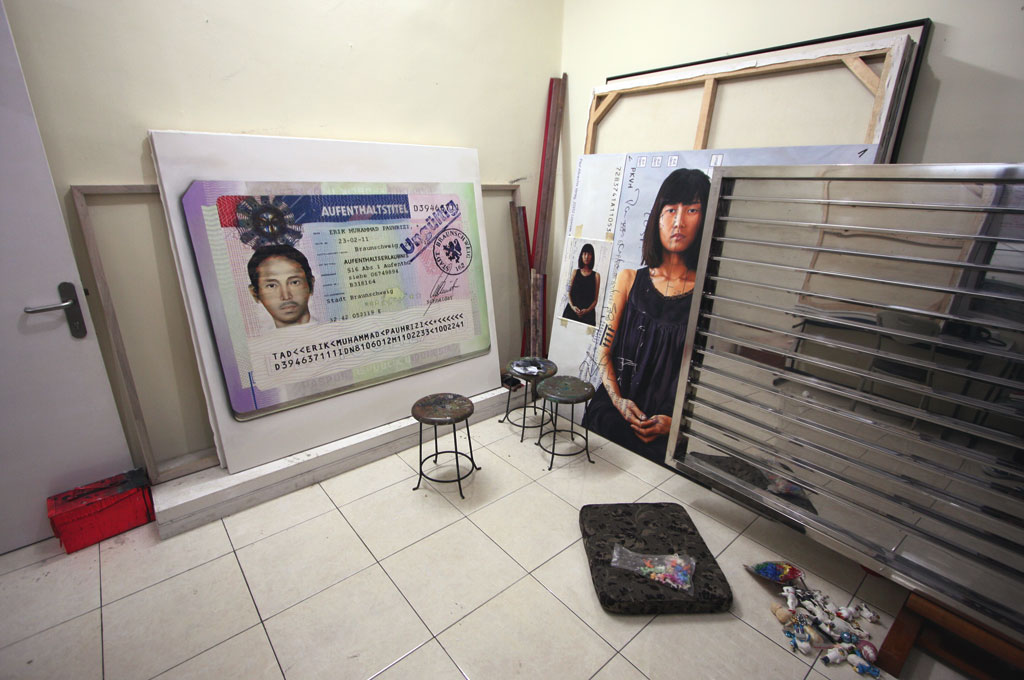
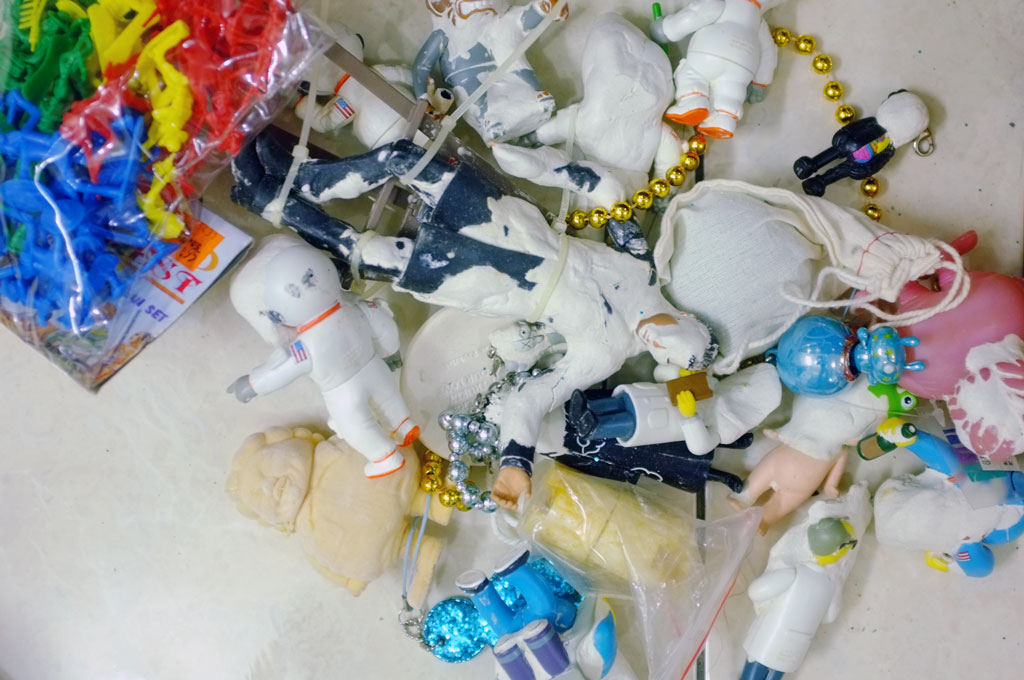

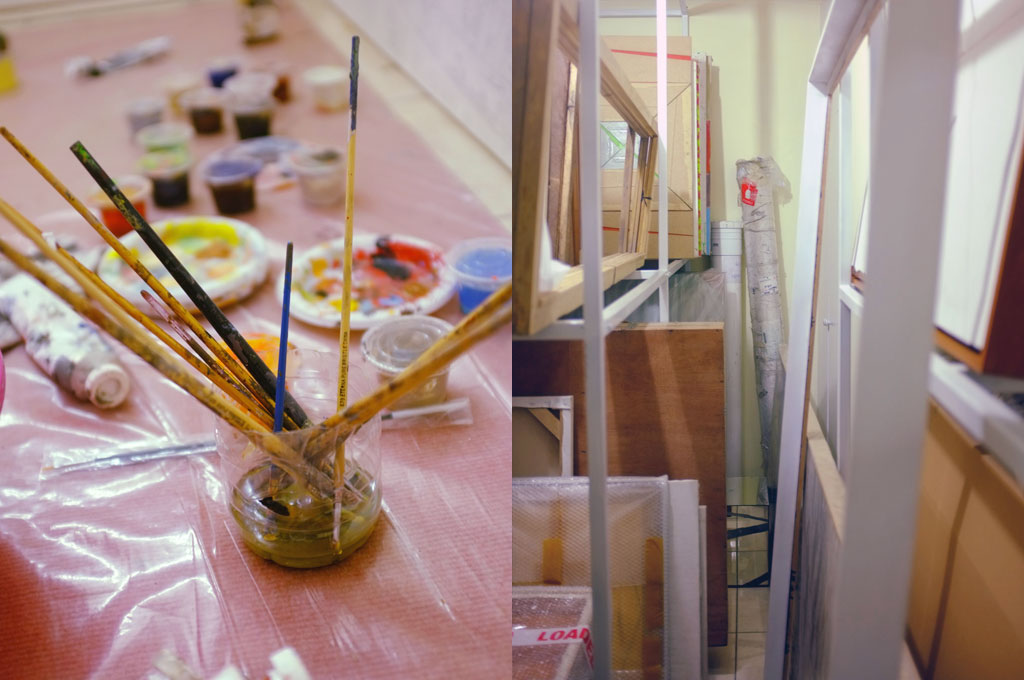
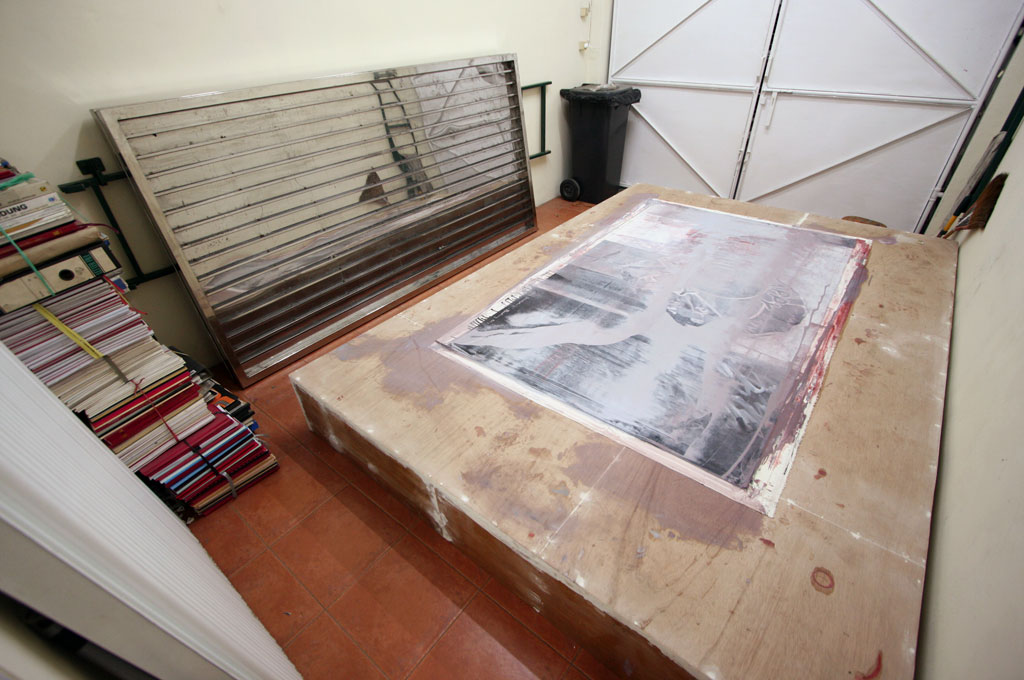
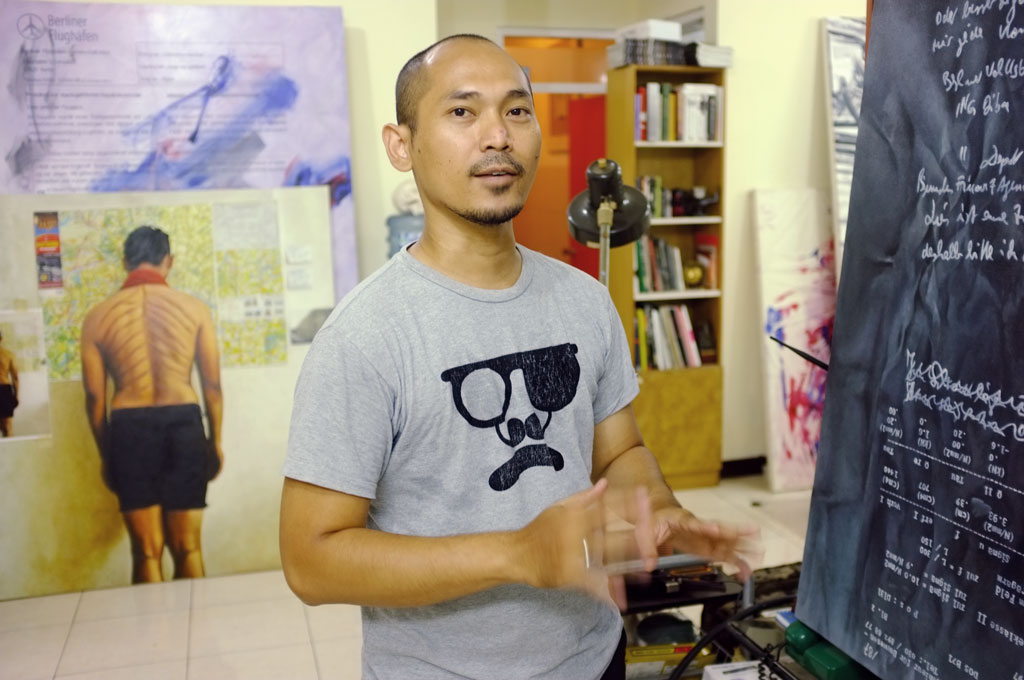
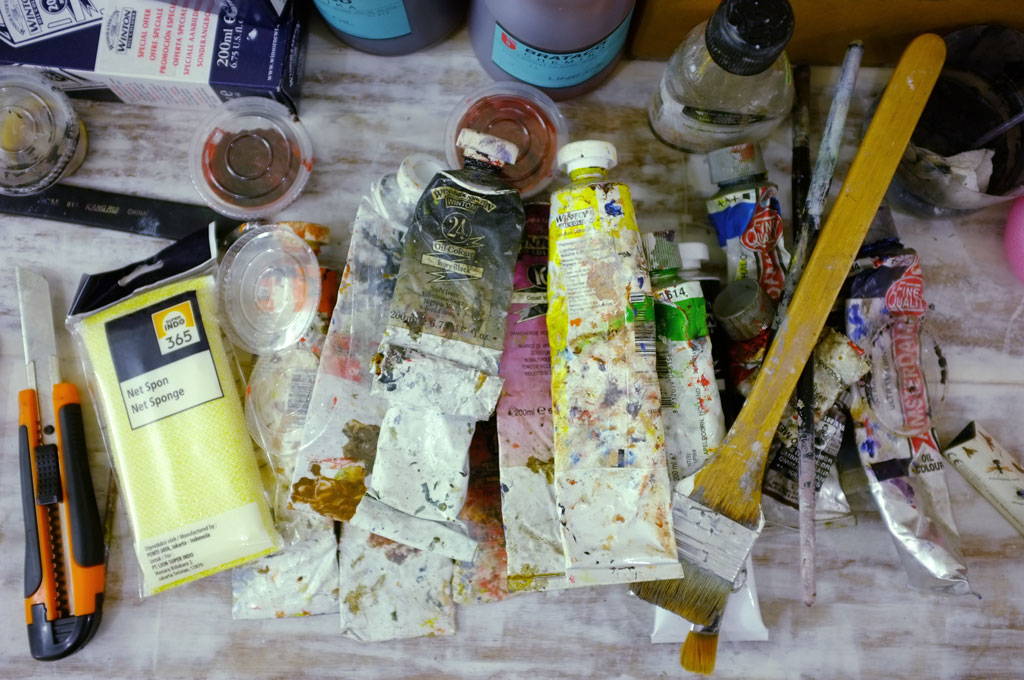
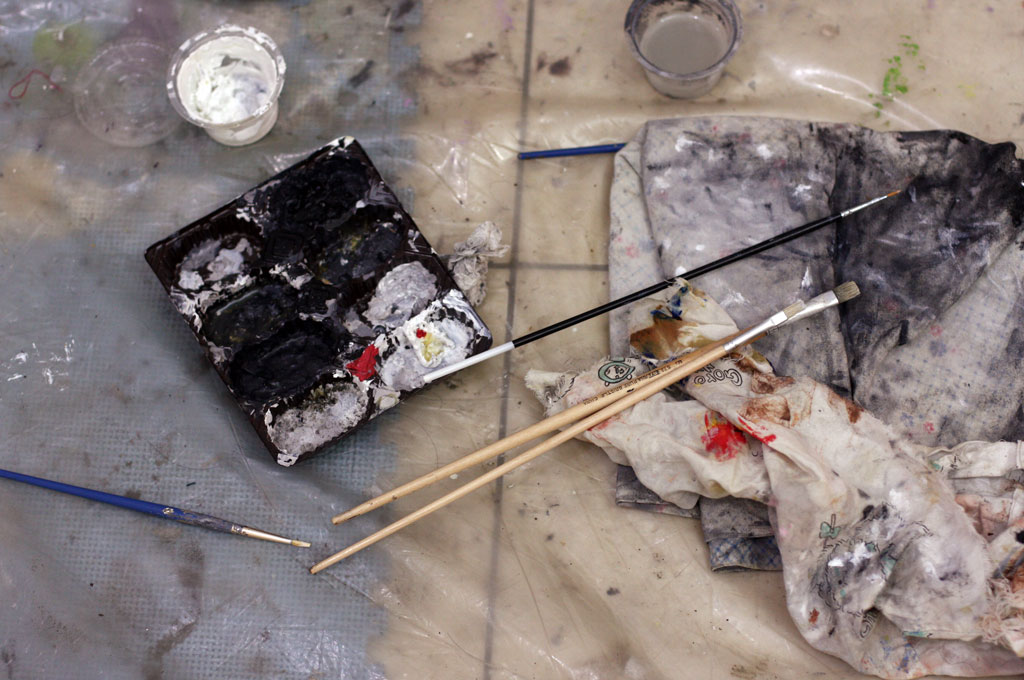
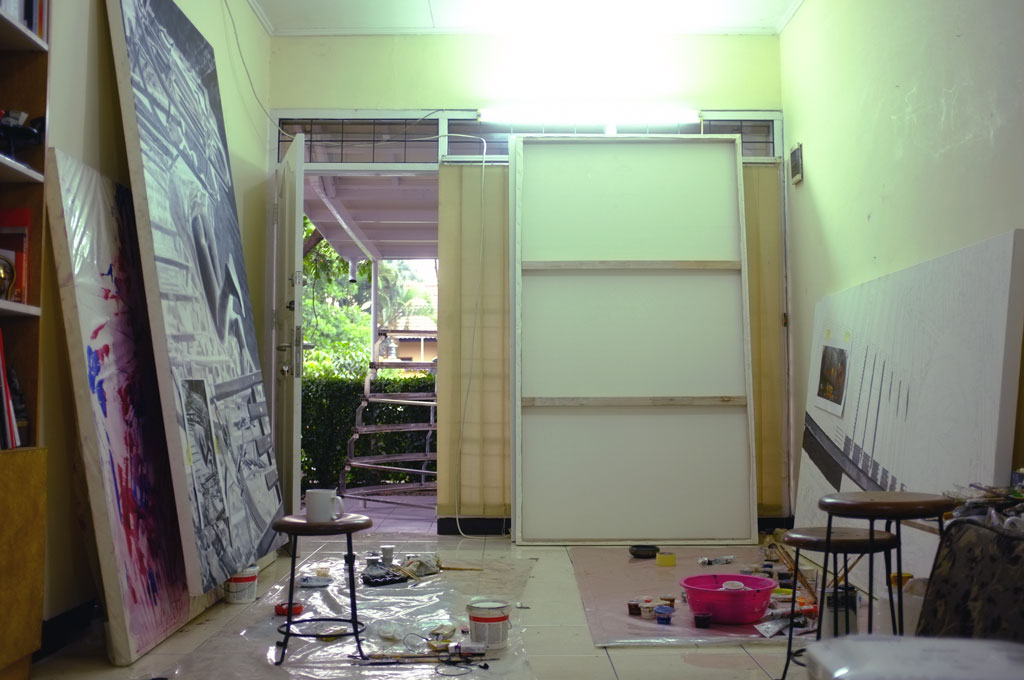
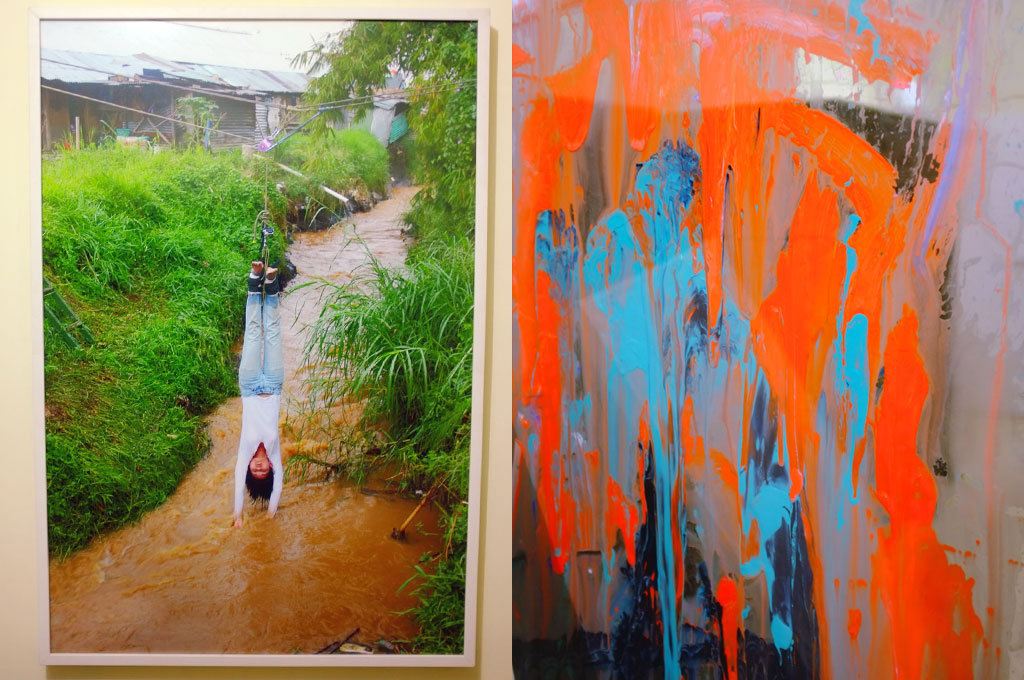
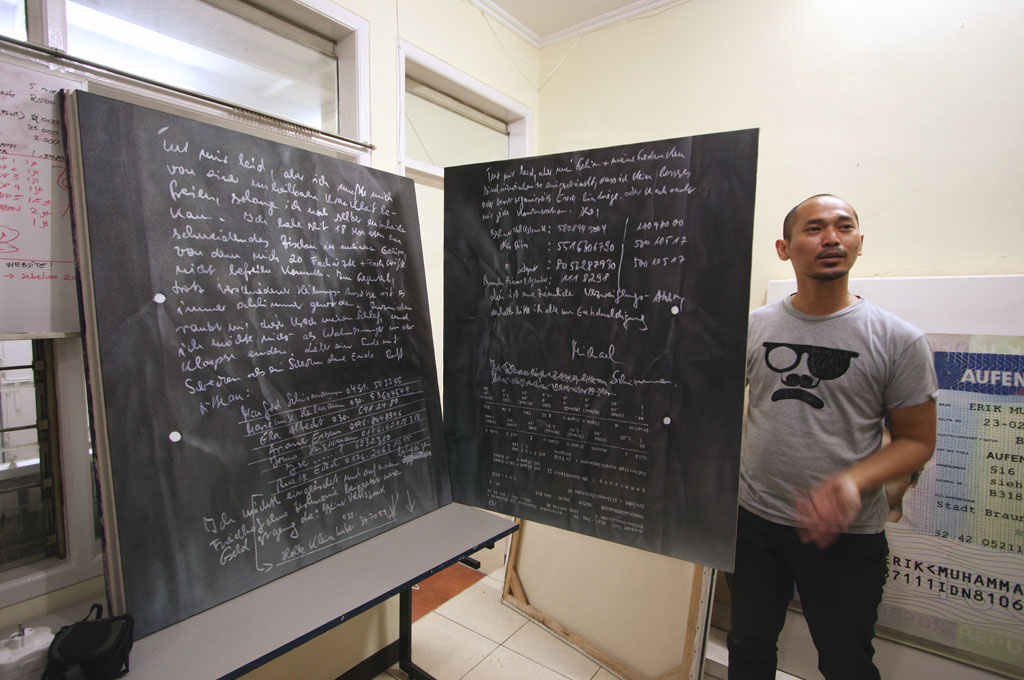
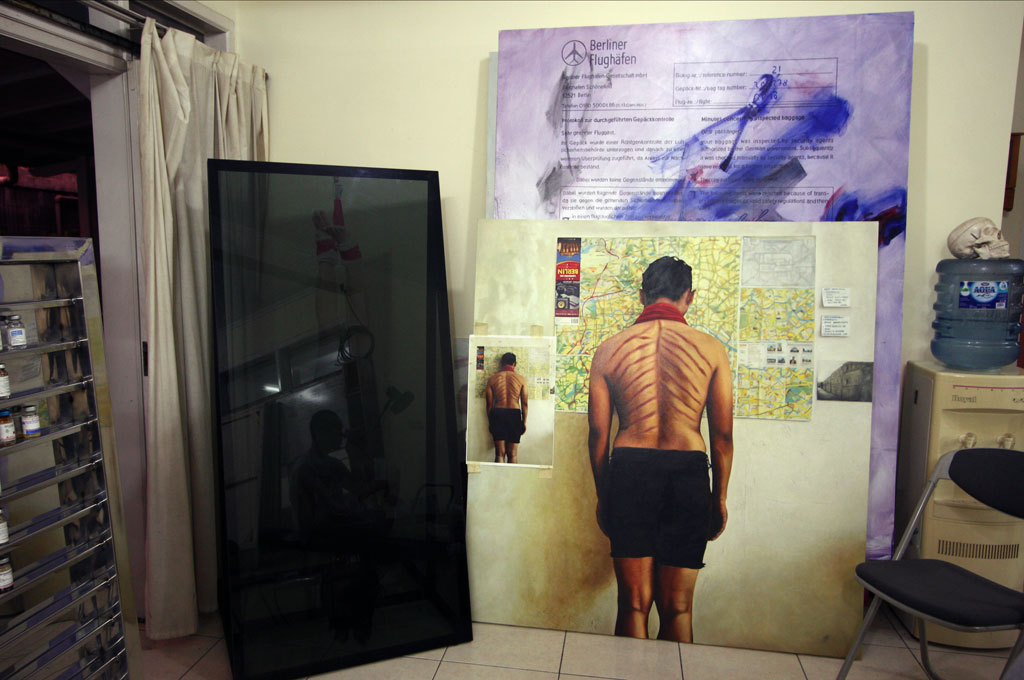
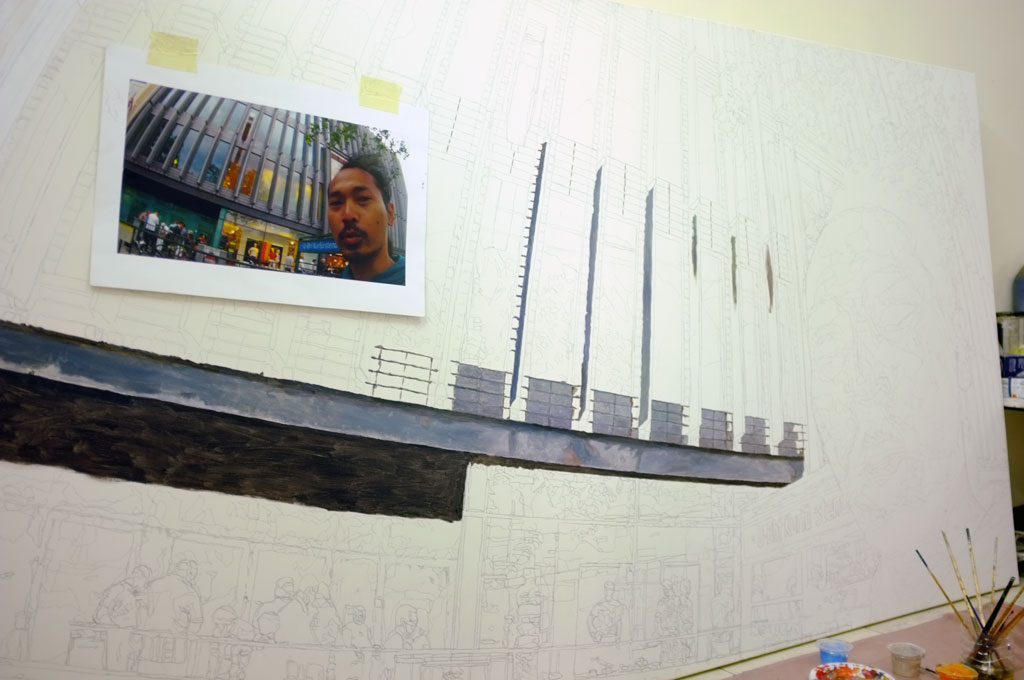
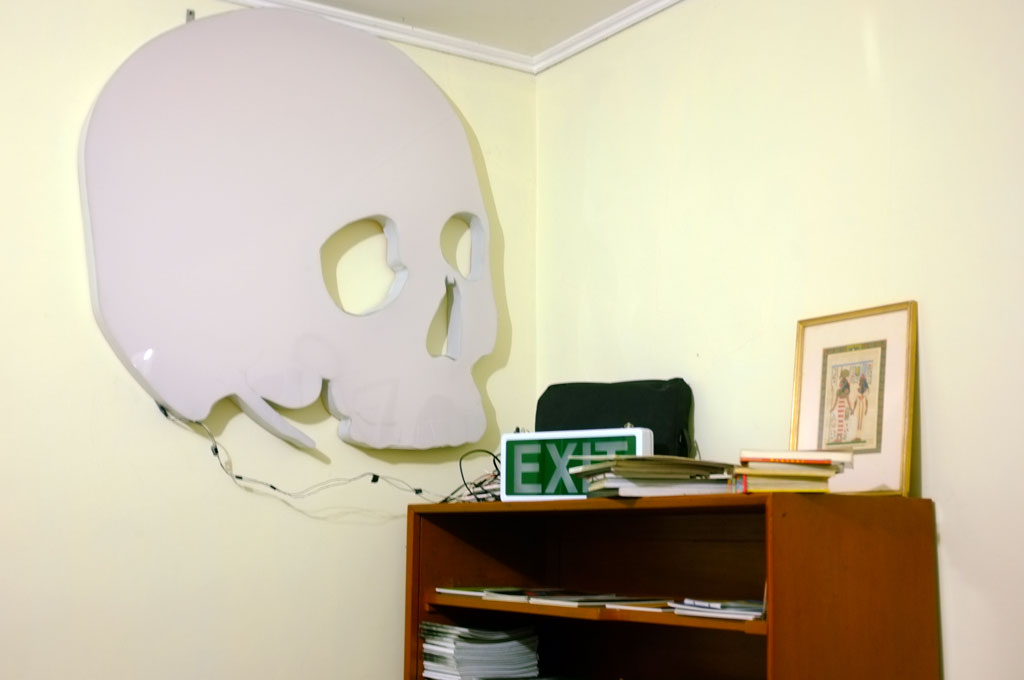
K
Can you tell us how you first got into art? Looking at the bio on your website, it says that you went to school for engineering before transferring to the arts. Did you become interested while you were in school?
E
To get into a university here [Indonesia] you have to take a placement exam, and unfortunately I broke my right arm in a motorcycle accident before the exams for the art program, which included illustration. Like many Bandung kids at the time, I was really into motorcycles… I even joined a motorcycle gang! (laughs)
Anyway, I only had my left hand to work with at the exam and that proved to be really difficult. I even needed the help of a fellow student to help me fill the answer sheet – I just couldn’t use my hands. My two older brothers took engineering, and since I really didn’t stand a chance to be accepted to Institut Teknologi Bandung (ITB) program, I should just take engineering and was accepted at IKIP (Institut Keguruan dan Ilmu Pendidikan).
So I took mechanical engineering at IKIP and I thought I would get to work with machinery… I was so wrong! It was all about math and equations! It didn’t live up to my expectations (laughs).
K
(Laughs) Math isn’t one of your strong points?
E
Not at all! The whole time there I was waiting to get my hands on automobile engines and it never happened.
During the two years I was there, I ended up being active in this organization called KABUMI (Keluarga Bumi Siliwangi) that did traditional Indonesian arts and crafts.
K
What sort of activities did you do?
E
It’s like an afterschool activity where we created exhibitions and performances with dance and music. We performed mostly outside of school plus we got paid for it. We have actually been invited to perform in the Presidential Palace 6 times.
K
Really? What were the occasions?
E
Usually we would get invited when there are foreign dignitaries in Indonesia. They would ask us to perform Indonesian music to welcome them.
K
And all of this happened while you were taking Mechanical Engineering?
E
Yes. I really enjoyed the activities in KABUMI, especially the process of learning, making concepts, and creating music, dance. Truthfully, I am not talented in music or dance, but loved studying and creating them. That’s when it really dawned on me that I loved the arts, so after two years at IKIP I decided to take the examination to enter ITB again and I was accepted.
K
What was your experience learning the arts at ITB?
E
When I entered ITB, I actually took craft design (Kriya), not fine arts. The school had a metal craft program on its brochure, and seeing that I have previously learned the basics at IKIP, I thought that I should take it – I thought it would be interesting to use the skills I learned to make machines in creating sculptures. So yeah, I decided to take craft design.
Although it was on the brochure, they never opened the courses for metal crafting the four years I was there. The options available were ceramics and textile. I do not enjoy ceramics, and I do not want to study textile because I thought it was feminine. But I finally did end up choosing textile because I understood the subject more.
It felt very uncomfortable as I really thought that textile was feminine. It wasn’t until I had a professor from i Boras. He was one of the people behind IKEA.
K
A product designer?
E
Yes. That’s when I really understood that textile can go into other fields such as interior design, etc. For a long time working with that material was awkward, so I made it a point to learn as many different part of fine arts – I took painting classes, graphic arts, ceramics, semiotics. That was when I understood that it is about the idea/concept, and we can translate it through any medium, including textile.
K
You said that even before you were in school you already had an interest in the arts. Can you tell us a little bit about that?
E
I have always loved drawing and illustrating from a young age. My father does research on pests that are specific to ornamental plants and has these really colorful books that I enjoyed going through. There were these really detailed illustrations of beetles to people carrying pesticide.
I grew up in Cianjur in a small research compound, I didn’t have friends that were my age. All I had was my father’s assistant, and while I was with them all I did was draw. Later on in school I would win these drawing contests. That was my grasp of what fine arts was, only drawing. I didn’t understand that things such as film and graphic design were also part of the arts.
K
How did you develop your work after graduating from ITB?
E
After graduating from ITB I was mostly known as a new media artist. I used mostly video, photography, sound, lighting. What really boosted my confidence as an artist was this place called Selasar Sunaryo in Bandung. It is a pretty prestigious and difficult place to exhibit your work; even some of my professors couldn’t manage to display their work there. Through this workshop I was very lucky to have been selected to exhibit there. Then another time I was able to have a photo exhibition there. From there I understood what one must do to be able to do an exhibition – your network, what the independent route is like, the difficulties of being an artist.
I learned that there is an alternative route. It used to be that if you wanted to have an exhibition you would have to propose it to a gallery, a curator, or be chosen – I found an independent route that allows me to speak the issues I would like to address.
K
It is interesting that you want to take an alternative route. Is it that difficult to be part of that establishment?
E
Yes, definitely. It has become this network of friends with their own taste, and if they don’t like your work, then you won’t be given a chance.
K
How much clout do they have? Do they really decide who will be successful and who won’t be?
E
For example. Let’s say there is a researcher, gallery, or collector from abroad and they visit Bandung, they would contact the establishments and they will only exhibit the artists they like. I do not agree with that practice.
K
And so you created your own avenue so you can showcase your work.
E
Yes. Every artist can exist; there is a place for everybody. There is no beautiful or ugly art, and if an artist can showcase their work they will have the incentive to hone their skill and ideas.
Most fresh graduates have it tough. You are out there with your final project as a portfolio, but you do not know how to get a grant or an exhibition. There are these players that decide whether or not you are good enough. From what I have seen, around 20% of graduates attempt to be a professional artist, and by the second year half of them quit. You can’t blame them, they have to make art on a shoe-string budget, their savings are depleted.
K
How did you fare?
E
I managed to get clients who believed in my work and they started to purchase and collect my work.
K
And that was through the independent route you decided to take?
E
Yes.
K
This independent route, did you exhibit in the galleries that have already existed or…?
E
No, my friends and I created our own exhibition spaces. We once used a boarding house and used it as our exhibition space. Because people supported this DIY spirit, we decided to have other artists have exhibition there too.
K
Was this part of the Buton Kultur art space you helped initiate?
E
Yes, it was.
K
Can you explain a little bit about what Buton Kultur is?
E
Sure. So Buton Kultur is an alternative art space where young and upcoming artists can showcase their work whether fine arts, music, finished or unfinished, etc. At the very least through this art space their work could be known in Bandung, but with further promotion we can get the artist’s name known even more.
K
And how did your personal work develop during this time?
E
I started to work with textile again in response to my insecurities with the medium being feminine. I also started to paint and use illustration. I love the arts in general and try not to limit myself to preconceived notions that a certain style or medium is better than the other.
K
You then moved to Germany, why did you decide to move there?
E
Even from college, the books that we read came mostly from Europe and America, and the European books came mostly from Germany because there is Goethe Institut here. I read a lot of books, and my interest for German artists grew. After doing further research, it seems that Germany is the most appropriate place for me to continue my studies. I started sending applications for scholarships. Funny enough, I was awarded one to go the United States – I didn’t accept it because at the time because they wanted me to do something other than fine arts.
K
You did eventually go to New York around 2010, and worked with The New Museum. Can you tell us a little bit about that?
E
I worked at the New Museum as an assistant curator while studying the issue of artist initiatives – art spaces that aren’t established, non-profit… who are doing it more for the enjoyment. I had already begun my research on the subject, and it turns out the Museum was doing their own research on artist initiative spaces, so we traded information.
My intention of studying is to understand alternative avenues where the artist is not dependent on galleries, curator – they do not need to be ‘chosen’ by an institution. I found many examples of this during my research.
K
Can you describe what this independent route is like, perhaps an example of it?
E
How would one start their career in the arts but without a strong network? Well why not start with an open studio. It begins organically with your friends bringing their friends. Then you can do collective exhibitions and events with other artists. Through a consistent set of activities the space will be considered a quite bit more seriously. Invite a writer to cover the exhibition or the artists involved, invite your local media to spread the word. You strengthen your draw and relevancy by being active, and eventually the established art world – galleries, curators, museums – will come to you. But of course, you have to make adjustments accordingly.
K
In 2011, you also had an exhibition in New York at CATM Chelsea, how did that go about?
E
While I was at the New Museum I met a lot of people in New York’s art scene to do my research, CATM included. They came to my open studio, I went to their openings, and after talks they invited me to exhibit my work there. That is so far the best exhibition opening I have ever had, largely due to their artist management being superb. They are intense! They introduced me to every single person that came to the opening. It didn’t matter whether they were just onlookers or somebody with more clout; I was introduced to everyone. I have been offered another exhibition there, which I am still considering because I am based in Berlin so it is a bit difficult to ship the work to New York.
K
And after your exhibition you returned to Germany?
E
Yes, I returned to Germany and got my masters degree. Diplome, actually. In Germany there is basically Diplome, which is the equivalent of getting your bachelor and masters degree, and Meister Schueler, which is a postgraduate honorary degree. I’ve been offered a Meister Schueler, which I’m hoping to take very soon.
K
Something that we talk about often regarding the arts is whether or not the artist must dedicate themselves to their art. Can one do this…well…
E
Part time? Yes I believe that one has the ability to do it, but most of the time, and this is based on my observation of my friends, it seems that when one gets a steady job, the art stops.
K
Why do you think that is?
E
Well, your job will most likely be the focus of your attention. You have a responsibility to your profession because that is how you make ends meet, and if you do it half-heartedly then you’re just lying to your employers and yourself. If I took my work half-heartedly the result would be half ass, it will be as if I was playing around.
K
A fun fact is that you actually got married with the grant money you received while you stayed in New York, can you share the story with us?
E
Sure I can.
K
You won’t get arrested or anything for divulging this information, right?
E
(laughs) No, of course not, they know everything. Basically I got a scholarship to be at the Westbeth Artist Community [Note: this was during the same time as Erik was studying at the New Museum]. I was there for 4 months, and during that time I managed to save half of that grant. With that money I managed to get a professional camera with an equally expensive lens, and a projector. So I asked the Asian Cultural Council what I should do, I still had all this money. They told me to buy books, but in Germany I have the ability to access any book from anywhere on the planet. In my school library back in Germany I can do a 3-euro deposit and the library will look for that book wherever it may be. So anyway, I asked them if I can use the money to get married with Erika [Ernawan], they said okay, so we got married (laughs!).
K
For your work, what are the themes that you address in your art?
E
When I graduated up until about 2007 I did new media art, creating videos, sound art, I also dabbled in VJ-ing. I then worked on more conventional mediums such as painting and textile until about 2010. When I moved to Germany, I experienced more concept-heavy art – where the idea/concept’s value is far more important than the medium that it is packaged in. I myself became interested in light, as no art – or life for that matter – can exist without light. It was a subject I began exploring, taking classes that had to do with it while I was in university.
I then looked at my own reality, particularly my journey and expectation being Indonesian and moving to a foreign country. I found what I looked for when I moved to Germany, but I also experienced discrimination as a person from a poor country.
K
A basic question that arises is appreciating art. Often times there the arts feels very exclusive and you can only ‘get it’ if you study. How does a person such as myself, who has very limited or no knowledge of art, experience and appreciate art?
E
I have struggled with that thought as well. At times the art scene closes itself from the rest of the world, and only allow the select few that ‘understand’ enter. They often speak of life, that art represent life, and at times saying that art is more important than life.
After my studies in Germany and the US, which was full of both happiness and sadness, I really understood that life is much bigger than art. That is the reason why my current work revolves around my personal experience, because life is relatable; it is a language everyone understands. Rather than speaking about art that no one will understand, I’d rather share my experiences with you. The information that I share is the art.
K
When you create your art, do you have an expectation for viewers to relate/understand the concept?
E
That is something that I think the public should decide. I deliver my information to the public and their response is theirs. If there was an expectation, perhaps desire being a more appropriate word, is that the audience can add their own opinions and information to it. I do not want to lecture the audience.
K
Your work is a starting point to a discussion.
E
Yes.
K
What is the art scene like in Indonesia?
E
It’s healthy and unhealthy, but not as healthy as it is abroad. They have everything abroad; you like underground music you can find it, then you want to listen to jazz you can find it. You’re basically free to explore a variety of arts.
Here, there is some exclusivity. As the arts that we know originated in the west, some people have this belief that being more ‘western’ makes you more superior. Or those who have more information have the right to decide what is good and what isn’t. Meanwhile abroad, it sort of doesn’t matter anymore what is good and what isn’t; everything just happens. Everybody is doing their own thing.
K
What is next, what are you working on right now?
E
Erika and I have been talking about an art space like Buton Kultur, but this time run by us two. We want to have a space where we can share information on how to live as artists, creating proposals, portfolio etc.
We have also been talking about creating an event that is open for everyone to participate in. We’ve been talking to our friends here in Bandung in creating a three-day event where artist and galleries can exhibit their work and have open studios. We would make a map/guide for people to find their way to the open studios. This will hopefully give a platform for artist to share their work with the public.
K
It seems like what the artists in Indonesia need is really a place where they can get exposure.
E
Yes, a place where you can bridge the gap between the artists and the public. Hopefully this project can be the beginning of a new approach to exhibiting art.
K
When do you think you will start this work?
E
As soon as we gather enough funds to make it (laughs).
K
Thank you so much for sharing with us your experiences and opinions. Is there anything else you would like to add?
E
Well, there is one of our work that I would like to share with you. So me being from a third world country my work revolves on the difficulties and discrimination that I face as an outsider. This letter that my neighbor wrote has added a new perspective to my experience. My neighbor in Germany wrote us a letter, and I painted his letter on this large canvas so everyone can see it clearly [photo 13/15]. He was a very close friend to me and Erika.
What he wrote in his letter is his being very ill for the past 18 months. He has visited multiple doctors but none of them has been able to cure his illness. The last two months, he has felt the energy in his body diminish and isn’t strong enough to continue. Our neighbor ended up committing suicide by jumping in front of a train.
This was basically his suicide letter, as you can see he put the numbers of his closest family members for us to contact them after his passing. He felt that he was unable to reveal his problems to a fellow German, as the people in general are very stiff. As a foreigner I often speak about my experiences, and here is a local that feels even more uncomfortable in his homeland. Even if what happened is unfortunate, me and Erika are grateful that our neighbor shared his perspective. We were very shocked when we learned the news, and couldn’t speak to each other for days. We argued whether or not I should create this painting of the letter – is it too personal? Is the issue too sensitive? In the end I decided to because his is a story and experience that should be shared, and what results from it can be positive.









